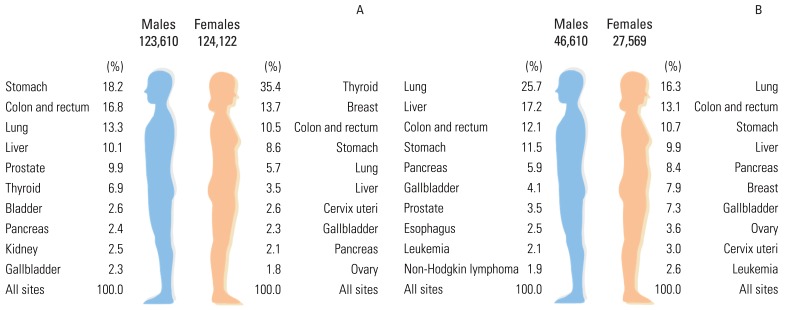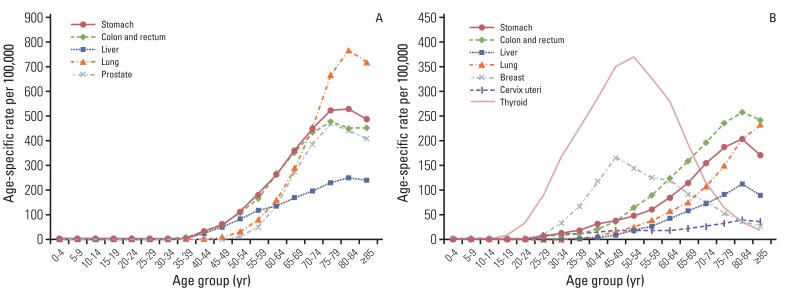Cancer Res Treat.
2013 Mar;45(1):15-21.
Prediction of Cancer Incidence and Mortality in Korea, 2013
- Affiliations
-
- 1The Korea Central Cancer Registry, Division of Cancer Registration and Surveillance, National Cancer Center, Goyang, Korea. astra67@ncc.re.kr
- 2National Cancer Control Institute, National Cancer Center, Goyang, Korea.
Abstract
- PURPOSE
To estimate the current cancer burden in Korea, cancer incidence and mortality rates were projected for the year 2013.
MATERIALS AND METHODS
Cancer incidence data from 1999 to 2010 were obtained from the Korea National Cancer Incidence Database, and cancer mortality data from 1993 to 2011 were obtained from Statistics Korea. Cancer incidence in 2013 was projected by fitting a linear regression model to observed age-specific cancer incidence rates against observed years, then multiplying the projected age-specific rates by the age-specific population. For cancer mortality, a similar procedure was used, except that a Joinpoint regression model was used to determine at which year the linear trend changed significantly.
RESULTS
In total, 247,732 new cancer cases and 74,179 cancer deaths are projected to occur in Korea in 2013. For all sites combined, the crude incidence rates are projected to be 489.8 and 492.2, and the age-standardized incidences to be 350.4 and 318.4 per 100,000 for males and females, respectively.
CONCLUSION
Cancer has become an important public health concern in Korea, and as the Korean population ages, the cancer burden will continue to increase.
Figure
Reference
-
1. Statistics Korea [Internet]. 2013. cited 2013 Jan 4. Daejeon: Statistics Korea;Available from: http://kostat.go.kr .2. Ministry of Health and Welfare. 2010 Annual report of cancer statistics in Korea. 2012. Seoul: Ministry of Health and Welfare.3. Jung KW, Park S, Kong HJ, Won YJ, Lee JY, Seo HG, et al. Cancer statistics in Korea: incidence, mortality, survival, and prevalence in 2009. Cancer Res Treat. 2012; 44:11–24. PMID: 22500156.
Article4. Shin HR, Won YJ, Jung KW, Kong HJ, Yim SH, Lee JK, et al. Nationwide cancer incidence in Korea, 1999~2001; first result using the national cancer incidence database. Cancer Res Treat. 2005; 37:325–331. PMID: 19956367.
Article5. Fritz A, Percy C, Jack A, Shanmugaratnam K, Sobin L, Parkin DM, et al. International classification of diseases for oncology. 2000. 3rd ed. Geneva: World Health Organization.6. World Health Organiztion. International statistical calssification of diseases and related health problems. 1994. 10th rev. Geneva: World Health Organization.7. Boyle P, Parkin DM. Jensen OM, Parkin DM, MacLennan R, Muir CS, Skeet RG, editors. Statistical methods for registries. Cancer registration: principles and methods. No. 95. 1991. Lyon: IARC;p. 126–158.8. National Cancer Institute. Joinpoint regression program, version 4.0 [Internet]. 2013. cited 2013 Jan 4. Bethesda, MD: National Cancer Institute;Available from: http://surveillance.cancer.gov/joinpoint/ .9. Segi M. Cancer mortality for selected sites in 24 countries (1950-1957). 1960. Sendai: Tohoku University School of Medicine.
- Full Text Links
- Actions
-
Cited
- CITED
-
- Close
- Share
- Similar articles
-
- Cancer Statistics in Korea: Incidence, Mortality, Survival, and Prevalence in 2013
- Prediction of Cancer Incidence and Mortality in Korea, 2012
- Prediction of Cancer Incidence and Mortality in Korea, 2011
- Prediction of Cancer Incidence and Mortality in Korea, 2015
- Prediction of Cancer Incidence and Mortality in Korea, 2024




